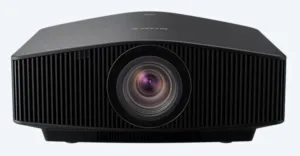There are a plethora of factors to consider when choosing a projector, whether it be for an office conference room, lecture theatre or home cinema. Opinions vary when it comes to certain features, as is natural with the subjective nature of display preferences. This has meant a term like Dynamic Contrast has adopted varying interpretations. However, to fully understand it, contrast alone must first be examined.

Contrast is one of the main factors deliberated over when choosing a projector as it significantly contributes to the day-to-day operation of the projector. Contrast ratio, in its basic form, is how much brighter the light of an all-white image is compared to an all-black image. With this, the ratio is calculated from the difference between the luminance of the brightest light (white) in comparison to the darkest colour (black).
Bigger doesn’t necessarily mean better…
The status quo when choosing a projector is to select the highest contrast ratio. The image details will be sharper and the higher contrast allows people to see the subtle shades of colour and individual frames of the film, the image is impacted whether it is a sweeping landscape, intricate graphs or small text. When calculating this for projectors, ISO (International Organization of Standards) is the go-to measurement. Using this classification system, the full on/off Contrast is measured using a solid white (on) against a solid black (off). Calculating the relationship between white and black images provides the contrast ratio. This means that even with the largest screens, people can experience a high-quality cinematic experience. More so with true 4K projectors, cinema owners can deliver consistently flawless pictures regardless of screen size. This poses the question: is a contrast ratio that claims to be 100,000:1 (meaning solid whites are 100,000 brighter than solid blacks) better than one that’s 10,000:1?
Manufacturers can manually manipulate the contrast range by measuring the darkest colour in different ways. Some consider black to be the lack of projected black or no black at all rather than solid black. This can lead to the common assumption that the higher the ratio the better the image quality. However, in some cases, a contrast ratio that claims to be 100,000:1 is not automatically better than one that’s 10,000:1.
Sony’s high end home theatre projector, the VPL VW995ES, uses both iris and laser control to optimise dynamic contrast. Image:Sony
Is it important?
Contrast ratio in a bright lecture theatre or meeting room under artificial lights is virtually impossible for people to notice. Higher dynamic range is, therefore, sometimes just a number on a spec sheet. An often truer measurement is required for similar scenarios such as a checkerboard image. This will provide a more accurate measure of true white and true black to define the contrast ratio rather than the number from the manufacturer.
What Matters Most?
When selecting a projector, what matters most is its ability to deliver a crisp and finely detailed image in any environment, alongside accurate, uniform colour. Requesting a demo to see the detail in the image is important – especially when considering how much ambient light is present in workspaces and universities – the screen needs to be both defined and distinct. A washed-out image without detail and inaccurate colour will provide a poor viewing experience and limited functionality.
Whether a projector is needed to host a large conference in a theatre, daily classroom presentations or display visuals across the office, there will always be a mutual desire for a finely detailed image with enhanced colour definition and uniformity.
 To avoid the misleading concept of dynamic contrast ratio, it is advised to question how the true ‘black’ and the true ‘white’ is measured and consider factors specifically related to colour definition to ensure you select the projector that delivers the highest definition you require. Of course, the intended use plays a part in the decision-making process but to ensure the highest quality, image sharpness and colour accuracy must not be compromised.
To avoid the misleading concept of dynamic contrast ratio, it is advised to question how the true ‘black’ and the true ‘white’ is measured and consider factors specifically related to colour definition to ensure you select the projector that delivers the highest definition you require. Of course, the intended use plays a part in the decision-making process but to ensure the highest quality, image sharpness and colour accuracy must not be compromised.
Rob Meakin – Product Manager, Business Projectors, Sony Professional Solutions Europe
Analyst Comment
This article was contributed by Sony and reflects the decision of Sony to stop quoting dynamic contrast numbers as they really don’t have much real world impact. As we have reported over the years, there have been a number of studies that have looked at ‘system contrast’ (i.e. the actual contrast on the screen of a typical projection scenario) and came to the conclusion that reflections from the environment and even from the faces of viewers, as well as light from, for example, emergency signs, raises the black level of projectors and effectively set the limit of contrast, rather than the projector. Once you get to a certain point, adding more contrast in the projector makes little difference to the system contrast.
We also took a similar view when quoting the dynamic contrast of monitors. The native contrast is important and the fact that there is some backlight control is interesting, but is of little real world use, as a metric. (BR)

